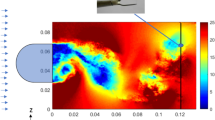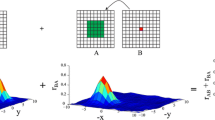Abstract
This paper deals with errors occurring in two-dimensional cross-correlation particle image velocimetry (PIV) algorithms (with window shifting), when high velocity gradients are present. A first bias error is due to the difference between the Lagrangian displacement of a particle and the real velocity. This error is calculated theoretically as a function of the velocity gradients, and is shown to reach values up to 1 pixel if only one window is translated. However, it becomes negligible when both windows are shifted in a symmetric way. A second error source is linked to the image pattern deformation, which decreases the height of the correlation peaks. In order to reduce this effect, the windows are deformed according to the velocity gradients in an iterative process. The problem of finding a sufficiently reliable starting point for the iteration is solved by applying a Gaussian filter to the images for the first correlation. Tests of a PIV algorithm based on these techniques are performed, showing their efficiency, and allowing the determination of an optimum time separation between images for a given velocity field. An application of the new algorithm to experimental particle images containing concentrated vortices is shown.













Similar content being viewed by others
References
Adrian RJ (1988) Statistical properties of particle image velocimetry measurements in turbulent flow. In: Adrian RJ et al. (eds) Laser anemometry in fluid mechanics—III. LADOAN Instituto Superior Tecnico, Lisbon, pp 115–129
Adrian RJ (1991) Particle-imaging techniques for experimental fluid mechanics. Annu Rev Fluid Mech 23:261–604
Fincham A, Delerce G (2000) Advanced optimization of correlation imaging velocimetry algorithms. Exp Fluids [Suppl] 29:S13–S22
Fincham AM, Spedding GR (1997) Low cost, high resolution DPIV for measurement of turbulent fluid. Exp Fluids 23:449–462
Hart DP (2000) PIV error correction. Exp Fluids 29:13–22
Huang HT, Fiedler HE, Wang JJ (1993a) Limitation and improvement of PIV Part I: Limitation of conventional techniques due to deformation of image patterns. Exp Fluids 15:168–174
Huang HT, Fiedler HE, Wang JJ (1993b) Limitation and improvement of PIV Part II: Particle image distortion, a novel technique. Exp Fluids 15:263–273
Ishikawa M, Murai Y, Wada A, Iguchi M (2000) A novel algorithm for particle tracking velocimetry using the velocity gradient tensor. Exp Fluids 29:519–531
Jambunathan K, Ju XY, Dobbins BN, Ashforth-Frost S (1995) An improved cross correlation technique for particle image velocimetry. Meas Sci Technol 6:507–514
Leweke T, Meunier P, Laporte F, Darracq D (2001) Controlled interactions of co-rotating vortices. In: Bütefisch K et al (eds) 3rd ONERA-DLR Aerospace Symposium (ODAS 2001). ONERA, Paris, paper S2-3
Lin HJ, Perlin M (1998) Improved methods for thin surface boundary layer investigations. Exp Fluids 25:431–444
Meunier P, Leweke T (2001) Three-dimensional instability during vortex merging. Phys Fluids 13:2747–2750
Meunier P, Leweke T (2003) Elliptic instability of a co-rotating vortex pair. J Fluid Mech in press
Meunier P, Ehrenstein U, Leweke T, Rossi M (2002) A merging criterion for two-dimensional co-rotating vortices. Phys Fluids 14:2757–2766
Nogueira J, Lecuona A, Rodriguez PA (1999) Local field correction PIV: on the increase of accuracy of digital PIV systems. Exp Fluids 27:107–116
Raffel M, Willert CE, Kompenhans J (1998) Particle image velocimetry: a practical guide. Springer, Berlin Heidelberg New York
Scarano F, Riethmuller ML (1998) Advances in iterative multigrid PIV image processing. Exp Fluids [Suppl] 29:S51–S60
Wereley ST, Meinhart CD (2001) Second-order accurate particle image velocimetry. Exp Fluids 31:258–268
Westerweel J (1993) Digital particle image velocimetry. PhD Thesis, Technical University Delft.
Willert CE, Gharib M (1991) Digital particle image velocimetry. Exp Fluids 10:181–193
Author information
Authors and Affiliations
Corresponding author
Appendix
Appendix
We seek an expression for the displacement Δr=r f−r i of a particle in the velocity field given by Eq. (3). At t=t i, the particle is located at r i, and at t=t f at r f. The origin of time (t=0) is given by the time at which one wishes to determine the velocity at the reference point 0 (of coordinates r=0). All derivatives are taken at this point and time. The particle trajectory r(t) is calculated by an iterative process as successive solutions of the differential equation
at increasing orders of t and r.
At first order, the solution r 1(t) of Eq. (32) [using Eq. (3) taken at order 0] is given by:
Introducing this result into (3) leads, at first order, to:
The solution of Eq. (34) is the approximation r 2(t) of the trajectory to the second order:
The third-order approximation r 3(t) of the particle trajectory is found in the same way, the final result being
-
Non-symmetric displacement: For the displacement corresponding to Fig. 1a, we have r i=0, and the choice t i=0 and t f=Δt seems appropriate. Using Eq. (35), this leads to Eq. (4), showing that, in this case, the error between the measured velocity Δr/Δt, and the true velocity v 0 at the measurement location and at the time of the first image is of second order in Δt. One could also choose the origin of time halfway between t i and t f [see Eq. (38) below], which means that the measured velocity field is associated with the instant between the exposures of the two images. In this case, the term proportional to ∂t v in Eq. (4) would vanish, but the error, now given by Eq. (39), would still remain O(Δt 2).
-
Symmetric displacement: For the displacement corresponding to the symmetric window shifting in Fig. 1b, the following relations hold:
Introducing Eq. (38) into Eq. (35), we obtain for t=t f:
and, with Eq. (37) and I being the unit matrix
This results in
showing that, for a symmetric displacement, the error is only of order Δt 3. The expression in Eq. (5) for this higher-order term is found by introducing Eqs. (37), (38) and (41) into Eq. (36).
Rights and permissions
About this article
Cite this article
Meunier, P., Leweke, T. Analysis and treatment of errors due to high velocity gradients in particle image velocimetry. Exp Fluids 35, 408–421 (2003). https://doi.org/10.1007/s00348-003-0673-2
Received:
Accepted:
Published:
Issue Date:
DOI: https://doi.org/10.1007/s00348-003-0673-2




